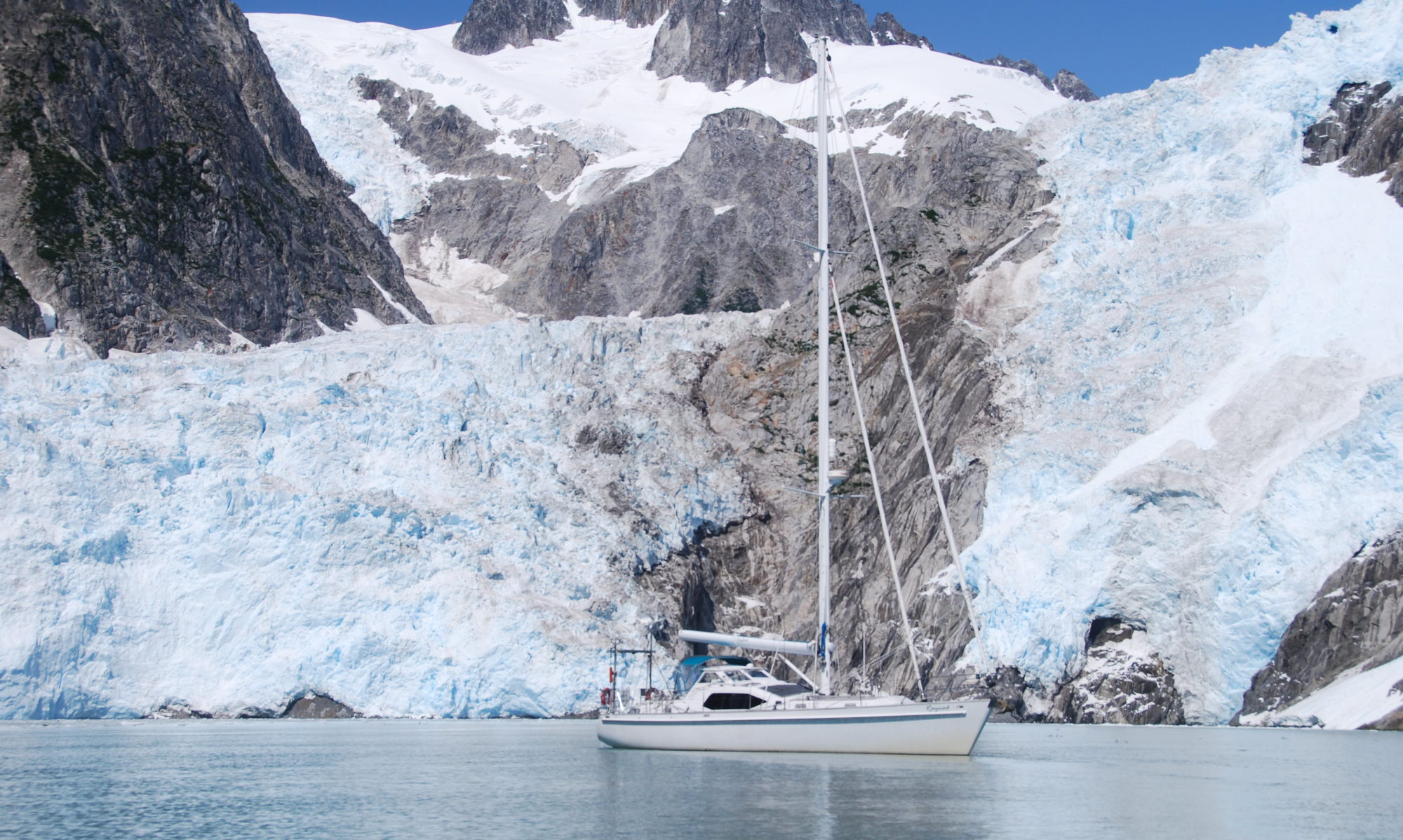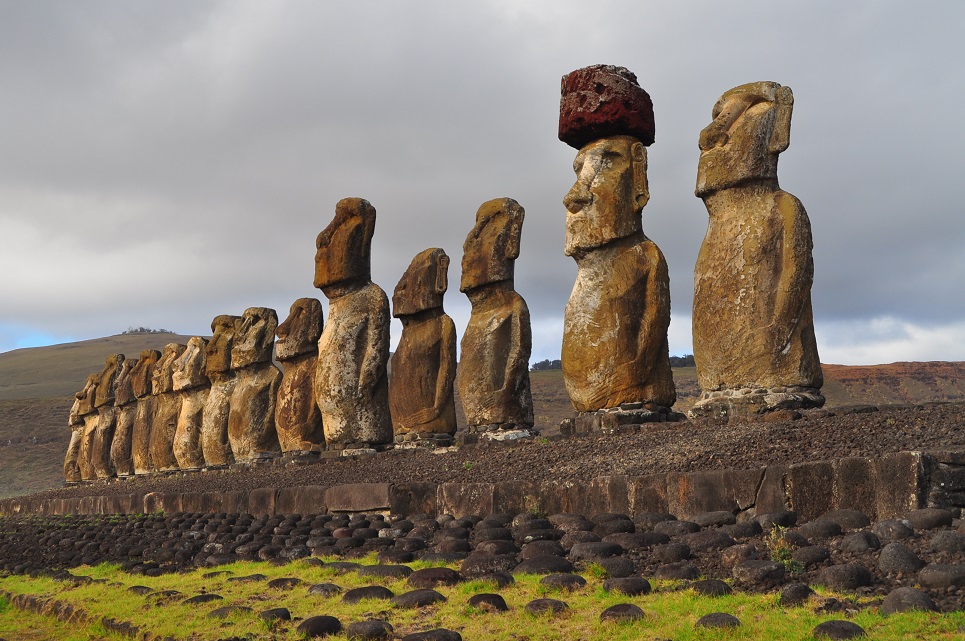 EASTER ISLAND – ISLA DE PASCUA
EASTER ISLAND – ISLA DE PASCUA
**Click here to see the : PHOTO GALLERY EASTER ISLAND**
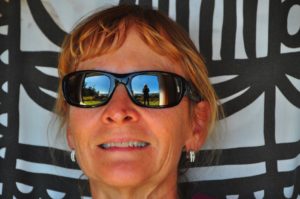
Kristy’s 60th Birthday Celebration
September 4-11, 2017

John surprised me with a trip to Easter Island to celebrate my 60th birthday! What an amazing journey this was. Via a rental Suzuki 4WD and lots of walking/hiking, we pretty much toured everywhere on the island. The famous Moai carvings are mysterious, huge and very interesting. The scenery is drammatic with a super rugged coastline, crashing waves, steep ragged cliffs, volcanic cones-craters, miles of grasslands (nearly all of the trees had been cut down although reforestation efforts have brought some eucalyptus and pine to areas) and lots of wild horses! 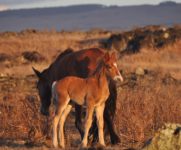 My favorite site was Rano Raraku which was the quarry where most of the Moai were carved and then transported and today there are many of them laying around or standing in various stages of creation allowing us to really appreciate the tremendous amount of work it was to carve and then transport these giant wonders.
My favorite site was Rano Raraku which was the quarry where most of the Moai were carved and then transported and today there are many of them laying around or standing in various stages of creation allowing us to really appreciate the tremendous amount of work it was to carve and then transport these giant wonders. 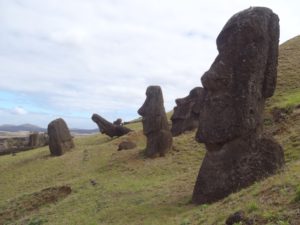 We lingered there for a long time just taking it all in from different angles. Although there were other travellers, this is the low season and we frequently had sites all to ourselves allowing us time to contemplate what we were seeing. We saw the 15 colossal Moai of Ahu Tongariki at sunrise and the Tahai at sunset on my birthday:) With 6.5-days, we were able to revisit several sites and enjoy nearly all of the many spectacular hikes including to the highest point, Volcano Taravaka, the entire crater rim of Rano Kau, and entering several caves including heart-stopping Ana Kagenga – with its long, narrow tube passages with openings in the cliffs looking out over the crashing surf below!
We lingered there for a long time just taking it all in from different angles. Although there were other travellers, this is the low season and we frequently had sites all to ourselves allowing us time to contemplate what we were seeing. We saw the 15 colossal Moai of Ahu Tongariki at sunrise and the Tahai at sunset on my birthday:) With 6.5-days, we were able to revisit several sites and enjoy nearly all of the many spectacular hikes including to the highest point, Volcano Taravaka, the entire crater rim of Rano Kau, and entering several caves including heart-stopping Ana Kagenga – with its long, narrow tube passages with openings in the cliffs looking out over the crashing surf below!

We left Papeete on Sept 4th at 3:30AM on a LAN Chile (Latam) flight direct to Rapa Nui, arriving at 1:35pm. I’d originally booked us a cabana (cabin) at the Cabana Tongariki , however, when we arrived they had “rebooked” us to his brothers cabin and no one was there to meet us at the airport! A kind tour guide made a few calls on our behalf and eventually ended up driving us to our new accommodations. Nice people, but not at all what we’d planned on: rather unclean, weird floorplan with a super tiny bathroom, cold water, no towels at first and no door locks on the outside bedroom door, only on the kitchen!?!? So after 2 nts, we paid up (US$) and moved ourselves over to a rather swank Hotel Altiplanico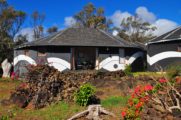 where we now had a clean and comfortable room, wonderful bathroom with hot water shower, a terrific view out over the ocean, huge breakfast buffet and as an added bonus, they let us keep the room at no charge until 10pm on our day of departure (0:15am flight).
where we now had a clean and comfortable room, wonderful bathroom with hot water shower, a terrific view out over the ocean, huge breakfast buffet and as an added bonus, they let us keep the room at no charge until 10pm on our day of departure (0:15am flight).
Suggested Resource:
A COMPANION TO EASTER ISLAND, by James Grant-Peterkin
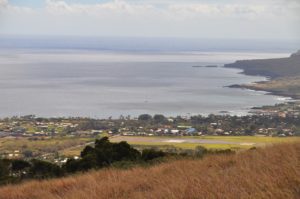 HANGA ROA – The main city sporting lovely views over the surf, with many lodging and restaurant options, ATMs, grocery & souveneir shops, near the Mataveri Int’l Airport with two small harbors for fishing boats,or dingys (a
HANGA ROA – The main city sporting lovely views over the surf, with many lodging and restaurant options, ATMs, grocery & souveneir shops, near the Mataveri Int’l Airport with two small harbors for fishing boats,or dingys (a

challenging approach and quite a swell once inside). Within walking distance of town are the sites of Tahai, Hanga Kio, AnaKai Tagata, Orongo, Rano Kau Crater andVinapu. We rented a car which was perfect for independantly making our way around to more of the sites.
A few of THE SITES:
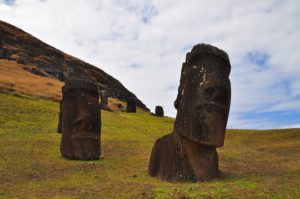 RANO RARAKU– Absolutely a highlight of our visit. This is the quarry where moai can be seen in various stages of creation, some upright, others leaning over, others face down or broken, and some just beginning to emerge from the cliff. It’s a real mystery why they are left this way and even more fascinating to realize that we are only seeing about a third of the full statue. It would have been interesting if Thor Heyerdahl, who had excavated down to the full depth of one moai, had arranged to leave the excavation and incase it into a viewing shelter so we could all take in the gigantic size of 13 meters! There are reportedly 397 moai scattered around this site, however, we were restricted to certain paths and probably saw only about a fourth of the total moai.
RANO RARAKU– Absolutely a highlight of our visit. This is the quarry where moai can be seen in various stages of creation, some upright, others leaning over, others face down or broken, and some just beginning to emerge from the cliff. It’s a real mystery why they are left this way and even more fascinating to realize that we are only seeing about a third of the full statue. It would have been interesting if Thor Heyerdahl, who had excavated down to the full depth of one moai, had arranged to leave the excavation and incase it into a viewing shelter so we could all take in the gigantic size of 13 meters! There are reportedly 397 moai scattered around this site, however, we were restricted to certain paths and probably saw only about a fourth of the total moai.
 ORONGO & RANO KAU CRATER RIM– The most dramatic setting on the island, the community of Orongo features slate stone houses with tiny doors and sod roofs purched out on the edge of the crater. Here the mythology of the Bird Man is that each September flocks of migratory Sooty Terns would arrive on the offshore islets and a competition was set where young men would try to be the first to swim across to the islet, snag a tern egg and safely swim it back to the crater rim village and present it to their chief. The winner’s chief would become that year’s Birdman. Such competitions amongst the warring tribes likely aided in the demise of all the sea birds around Easter Island. It was odd and sad to be in such a lovely location so isolated from everywhere else and yet have almost no seabirds to enjoy.
ORONGO & RANO KAU CRATER RIM– The most dramatic setting on the island, the community of Orongo features slate stone houses with tiny doors and sod roofs purched out on the edge of the crater. Here the mythology of the Bird Man is that each September flocks of migratory Sooty Terns would arrive on the offshore islets and a competition was set where young men would try to be the first to swim across to the islet, snag a tern egg and safely swim it back to the crater rim village and present it to their chief. The winner’s chief would become that year’s Birdman. Such competitions amongst the warring tribes likely aided in the demise of all the sea birds around Easter Island. It was odd and sad to be in such a lovely location so isolated from everywhere else and yet have almost no seabirds to enjoy.
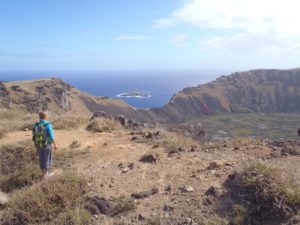 Hiking up the mountain and to the other side of the crater gave us some spectacular views. The suppressant drug Rapamycin was discovered in some of the soil on Rano Kau.
Hiking up the mountain and to the other side of the crater gave us some spectacular views. The suppressant drug Rapamycin was discovered in some of the soil on Rano Kau.
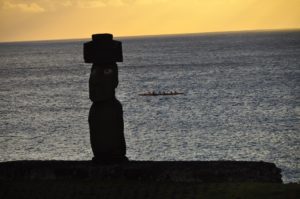
TAHAI, AHU VA URI & HANGA KIO’E- The quintessential sunset moai, Tahai has recreated eyes and his red topknot, which makes this an outstanding example; he is set on a large platform with his back to the beautiful shoreline of surf crashing against the rocks. Nearby are the the other moai

TONGARIKI– Containing 15 gigantic moai,this is the largest platform measuring 220 meters in length, it is a ceremonial alter with increasingly larger statues/moai that was completely knocked down in the 1960 tsunami and later reconstructed by the Japanese. 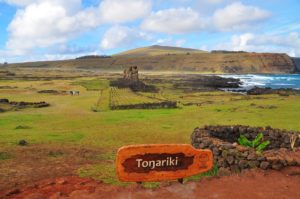 Quite an undertaking as the largest moai weighed 88 metric ton – a big job for commercial cranes so we can only wonder how in the world this ancient civilization managed to not only carve these colossal moai, but also move them over several kilometers of rather rough terrain. There are many theories and even re-creations of how this may have been done, but no certain answers to that mystery. We visited this site at least three times, once in the early evening and again for the sunrise. There are also some petroglyphs, other moai and stone structures. Unfortunately, most of the petroglyphs we found around the island were becoming very faint from wear and lack of protection from the elements.
Quite an undertaking as the largest moai weighed 88 metric ton – a big job for commercial cranes so we can only wonder how in the world this ancient civilization managed to not only carve these colossal moai, but also move them over several kilometers of rather rough terrain. There are many theories and even re-creations of how this may have been done, but no certain answers to that mystery. We visited this site at least three times, once in the early evening and again for the sunrise. There are also some petroglyphs, other moai and stone structures. Unfortunately, most of the petroglyphs we found around the island were becoming very faint from wear and lack of protection from the elements.
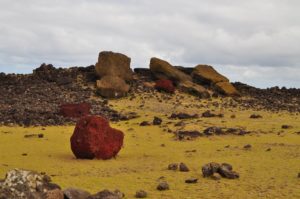 AKAHANGA– Platforms and toppled moai and broken ahu. Lots of horses and cows around due to the natural spring water outlet.
AKAHANGA– Platforms and toppled moai and broken ahu. Lots of horses and cows around due to the natural spring water outlet.
AHU HANGA TE’E – Set around the bay this platform used to support 8 moai which are now lying face down, however there are several of their red topnot headpieces still in good shape,although knocked off their heads. VINAPU – A great example of later platform construction using large, straight cut stone slabs.
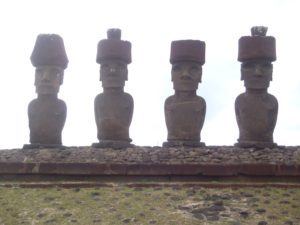
Ahu Nau Nau, ANAKENA– The best beach on the island is also the setting for the best preserved moai because they had fallen face first into the sand which protected their features and detailed carvings until they were resurrected by Sergio Rapu, the first Rapa Nui anthropologist, in 1978.
 AHU AKIVI- These moai appear to face out to sea, but in fact are seven inland moai set to look out over the villagers and farms. This platform is actually aligned with certain starts on the spring and autumnal equinoxes which fits with their importance to the farmers. TERAVAKA– the mountain hike takes off near here with a long walk through the farming/ranch lands, up and over several crater vents before reaching the summit. We had all types of weather on this hike, even some windy sleet!
AHU AKIVI- These moai appear to face out to sea, but in fact are seven inland moai set to look out over the villagers and farms. This platform is actually aligned with certain starts on the spring and autumnal equinoxes which fits with their importance to the farmers. TERAVAKA– the mountain hike takes off near here with a long walk through the farming/ranch lands, up and over several crater vents before reaching the summit. We had all types of weather on this hike, even some windy sleet!

VOLCANO TERVAKA HIKE– It’s only 507meters high, but the hike begins about 9 km away making this a pretty decent trek. Not difficult, just long and we unfortunately did not have great weather – lots of rain and strong winds, so our view from the top was mostly wiped out by the weather. Still fun though and we occasionally got some glimpses of views allowing us to take in the entire circumference of the island. All of the hikes are available by horseback, so horse pooh was a significant obstacle to watch out for. One guy even biked up!
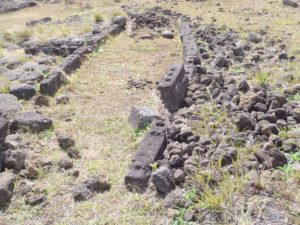
TE PEU – Village Site reached only via hiking (or horseback) was well worth the effort as it is the best representation remaining of what a village may have looked like with many of the boat shaped housing stones remaining, large true cut slab platforms with broken moai, manavai (stone circles encasing gardens), chicken houses and a view.
CAVES

ANA KAI TANGATA– a cave easily approached and entered with some fairly well preserved cave paintings inside and crashing surf outside.
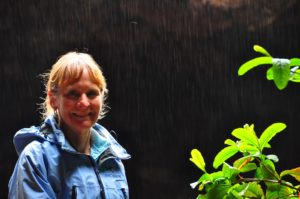
ANA TE PAHU- Easy to enter with banana trees growing in one area that opens to the sky providing unique lighting contrasts between the darkness of the connecting caves.
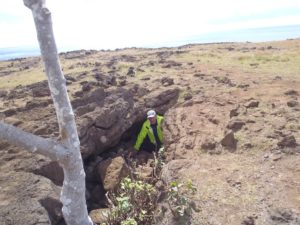
ANA TE PORO- Bit more of a hike to get inside, a tube cave with a very narrow exit.
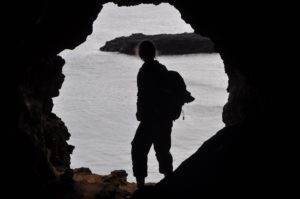 ANA KAKENGA- Heartstoppingly spectacular cave only reached via a long narrow tube (not my favorite part!) but coming out after about 30 meters to an opening right out over the sea cliffs, a view of the crashing surf and two islets below. Both thrilling and stunningly beautiful.
ANA KAKENGA- Heartstoppingly spectacular cave only reached via a long narrow tube (not my favorite part!) but coming out after about 30 meters to an opening right out over the sea cliffs, a view of the crashing surf and two islets below. Both thrilling and stunningly beautiful.
